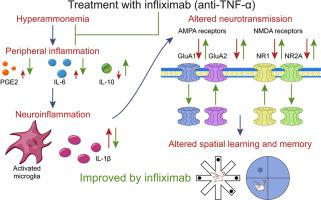当前位置:
X-MOL 学术
›
J. Hepatol.
›
论文详情
Our official English website, www.x-mol.net, welcomes your
feedback! (Note: you will need to create a separate account there.)
Chronic hyperammonemia induces peripheral inflammation that leads to cognitive impairment in rats: reversal by anti-tnfa treatment
Journal of Hepatology ( IF 26.8 ) Pub Date : 2020-09-01 , DOI: 10.1016/j.jhep.2019.01.008 Tiziano Balzano 1 , Sherry Dadsetan 1 , Jerónimo Forteza 2 , Andrea Cabrera-Pastor 1 , Lucas Taoro-Gonzalez 1 , Michele Malaguarnera 1 , Sara Gil-Perotin 3 , Laura Cubas-Nuñez 4 , Bonaventura Casanova 3 , Agueda Castro-Quintas 1 , Alejandro Ponce-Mora 1 , Yaiza M Arenas 1 , Paola Leone 1 , Slaven Erceg 5 , Marta Llansola 1 , Vicente Felipo 1
Journal of Hepatology ( IF 26.8 ) Pub Date : 2020-09-01 , DOI: 10.1016/j.jhep.2019.01.008 Tiziano Balzano 1 , Sherry Dadsetan 1 , Jerónimo Forteza 2 , Andrea Cabrera-Pastor 1 , Lucas Taoro-Gonzalez 1 , Michele Malaguarnera 1 , Sara Gil-Perotin 3 , Laura Cubas-Nuñez 4 , Bonaventura Casanova 3 , Agueda Castro-Quintas 1 , Alejandro Ponce-Mora 1 , Yaiza M Arenas 1 , Paola Leone 1 , Slaven Erceg 5 , Marta Llansola 1 , Vicente Felipo 1
Affiliation

|
BACKGROUND & AIMS
Chronic hyperammonemia induces neuroinflammation which mediates cognitive impairment. How hyperammonemia induces neuroinflammation remains unclear. We propose the hypothesis that chronic hyperammonemia would induce peripheral inflammation that would induce neuroinflammation and cognitive impairment, which would be prevented by reducing peripheral inflammation. The aims of this work were to assess whether: 1) chronic hyperammonemia induces peripheral inflammation; 2) peripheral inflammation contributes to hyperammonemia-induced neuroinflammation, altered neurotransmission and impaired spatial learning; 3) hyperammonemia-induced inflammation and neurpoinflammation are reversible following hyperammonemia elimination; 4) reducing peripheral inflammation with anti-TNFa reduces neuroinflammation and improves neurotransmission and cognitive impairment in hyperammonemic rats. METHODS
Chronic hyperammonemia was induced by feeding rats an ammonia-containing diet. Peripheral inflammation was analyzed by measuring prostaglandin E2 (PGE2), TNFa, IL-6 and IL-10. We tested whether chronic anti-TNFa treatment improves peripheral inflammation, neuroinflammation, membrane expression of glutamate receptors in hippocampus and spatial learning. RESULTS
Hyperammonemic rats show a rapid and reversible induction of peripheral inflammation, with increased pro-inflammatory PGE2, TNFa and IL-6, followed at around 10 days by reduced anti-inflammatory IL-10. Peripheral anti-TNFa treatment prevents peripheral inflammation induction and the increase in IL-1b and TNFa and microglia activation in hippocampus of the rats, which remain hyperammonemic. This is associated with prevention of the altered membrane expression of glutamate receptors and of the impairment of spatial memory assessed in the radial and Morris water mazes. CONCLUSIONS
This report unveils a new mechanism by which chronic hyperammonemia induces neurological alterations: induction of peripheral inflammation. This supports that reducing peripheral inflammation by safe procedures would improve cognitive function in patients with minimal hepatic encephalopathy. LAY SUMMARY
This article unveils a new mechanism by which chronic hyperammonemia induces cognitive impairment in rats: chronic hyperammonemia per se induces peripheral inflammation, which mediates many of its effects on brain, including induction of neuroinflammation, which alters neurotransmission, leading to cognitive impairment. It is also shown that reducing peripheral inflammation by treating rats with anti-TNFa, which does not cross the blood-brain barrier, prevents hyperammonemia-induced neuroinflammation, alterations in neurotransmission and cognitive impairment. This new view may have an important impact on the understanding of the mechanisms involved in minimal hepatic encephalopathy in cirrhotic patients and may allow developing new therapeutic approaches.
中文翻译:

慢性高氨血症诱导外周炎症,导致大鼠认知障碍:抗 tnfa 治疗逆转
背景和目的 慢性高氨血症会诱发神经炎症,从而介导认知障碍。高氨血症如何诱发神经炎症仍不清楚。我们提出假设,慢性高氨血症会诱发外周炎症,进而诱发神经炎症和认知障碍,而这可以通过减少外周炎症来预防。这项工作的目的是评估:1) 慢性高氨血症是否会诱发外周炎症;2) 外周炎症导致高氨血症引起的神经炎症、神经传递改变和空间学习受损;3)高氨血症引起的炎症和神经炎症在消除高氨血症后是可逆的;4) 用抗 TNFa 减少外周炎症可减少神经炎症并改善高氨血症大鼠的神经传递和认知障碍。方法通过给大鼠喂食含氨饮食诱导慢性高氨血症。通过测量前列腺素 E2 (PGE2)、TNFa、IL-6 和 IL-10 来分析外周炎症。我们测试了慢性抗 TNFa 治疗是否能改善外周炎症、神经炎症、海马中谷氨酸受体的膜表达和空间学习。结果 高氨血症大鼠显示出快速且可逆的外周炎症诱导,促炎性 PGE2、TNFa 和 IL-6 增加,随后在大约 10 天时抗炎性 IL-10 减少。外周抗 TNFa 治疗可防止外周炎症诱导以及大鼠海马中 IL-1b 和 TNFa 的增加以及小胶质细胞的激活,这些都保持高氨血症。这与防止谷氨酸受体膜表达的改变以及径向和莫里斯水迷宫中评估的空间记忆受损有关。结论 本报告揭示了慢性高氨血症诱导神经系统改变的新机制:诱导外周炎症。这支持通过安全程序减少外周炎症将改善轻度肝性脑病患者的认知功能。概述本文揭示了慢性高氨血症诱导大鼠认知障碍的新机制:慢性高氨血症本身诱导外周炎症,它介导了它对大脑的许多影响,包括诱导神经炎症,从而改变神经传递,导致认知障碍。研究还表明,通过用不穿过血脑屏障的抗 TNFa 治疗大鼠来减少外周炎症,可以防止高氨血症引起的神经炎症、神经传递的改变和认知障碍。这一新观点可能对理解肝硬化患者轻微肝性脑病的机制产生重要影响,并可能有助于开发新的治疗方法。它不会穿过血脑屏障,防止高氨血症引起的神经炎症、神经传递的改变和认知障碍。这一新观点可能对理解肝硬化患者轻微肝性脑病的机制产生重要影响,并可能有助于开发新的治疗方法。它不会穿过血脑屏障,防止高氨血症引起的神经炎症、神经传递的改变和认知障碍。这一新观点可能对理解肝硬化患者轻微肝性脑病的机制产生重要影响,并可能有助于开发新的治疗方法。
更新日期:2020-09-01
中文翻译:

慢性高氨血症诱导外周炎症,导致大鼠认知障碍:抗 tnfa 治疗逆转
背景和目的 慢性高氨血症会诱发神经炎症,从而介导认知障碍。高氨血症如何诱发神经炎症仍不清楚。我们提出假设,慢性高氨血症会诱发外周炎症,进而诱发神经炎症和认知障碍,而这可以通过减少外周炎症来预防。这项工作的目的是评估:1) 慢性高氨血症是否会诱发外周炎症;2) 外周炎症导致高氨血症引起的神经炎症、神经传递改变和空间学习受损;3)高氨血症引起的炎症和神经炎症在消除高氨血症后是可逆的;4) 用抗 TNFa 减少外周炎症可减少神经炎症并改善高氨血症大鼠的神经传递和认知障碍。方法通过给大鼠喂食含氨饮食诱导慢性高氨血症。通过测量前列腺素 E2 (PGE2)、TNFa、IL-6 和 IL-10 来分析外周炎症。我们测试了慢性抗 TNFa 治疗是否能改善外周炎症、神经炎症、海马中谷氨酸受体的膜表达和空间学习。结果 高氨血症大鼠显示出快速且可逆的外周炎症诱导,促炎性 PGE2、TNFa 和 IL-6 增加,随后在大约 10 天时抗炎性 IL-10 减少。外周抗 TNFa 治疗可防止外周炎症诱导以及大鼠海马中 IL-1b 和 TNFa 的增加以及小胶质细胞的激活,这些都保持高氨血症。这与防止谷氨酸受体膜表达的改变以及径向和莫里斯水迷宫中评估的空间记忆受损有关。结论 本报告揭示了慢性高氨血症诱导神经系统改变的新机制:诱导外周炎症。这支持通过安全程序减少外周炎症将改善轻度肝性脑病患者的认知功能。概述本文揭示了慢性高氨血症诱导大鼠认知障碍的新机制:慢性高氨血症本身诱导外周炎症,它介导了它对大脑的许多影响,包括诱导神经炎症,从而改变神经传递,导致认知障碍。研究还表明,通过用不穿过血脑屏障的抗 TNFa 治疗大鼠来减少外周炎症,可以防止高氨血症引起的神经炎症、神经传递的改变和认知障碍。这一新观点可能对理解肝硬化患者轻微肝性脑病的机制产生重要影响,并可能有助于开发新的治疗方法。它不会穿过血脑屏障,防止高氨血症引起的神经炎症、神经传递的改变和认知障碍。这一新观点可能对理解肝硬化患者轻微肝性脑病的机制产生重要影响,并可能有助于开发新的治疗方法。它不会穿过血脑屏障,防止高氨血症引起的神经炎症、神经传递的改变和认知障碍。这一新观点可能对理解肝硬化患者轻微肝性脑病的机制产生重要影响,并可能有助于开发新的治疗方法。










































 京公网安备 11010802027423号
京公网安备 11010802027423号